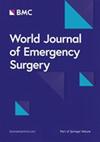基于术前CT成像的困难腹腔镜胆囊切除术放射学-临床预测模型:一项回顾性单中心研究
IF 5.8
1区 医学
Q1 EMERGENCY MEDICINE
引用次数: 0
摘要
术前准确识别困难的腹腔镜胆囊切除术(DLC)仍然是一个临床挑战。先前的研究利用临床变量或形态学成像标记已证明了次优的预测性能。本研究旨在将术前ct放射组学特征与临床特征相结合,建立最佳的放射组学-临床模型。回顾性分析本中心因胆囊炎行腹腔镜胆囊切除术的2055例患者。术前CT图像进行超分辨率重建以提高一致性,并提取胆囊壁区域的高通量放射学特征。使用Boruta-LASSO算法选择放射学和临床特征的组合。使用六种机器学习算法构建预测模型并进行验证,并根据AUC、准确性、Brier评分和DCA评估模型性能,以确定最优模型。使用SHAP方法进一步增强了模型的可解释性。Boruta-LASSO算法确定了模型构建的10个关键放射学和临床特征,包括Rad-Score、胆囊壁厚度、纤维蛋白原、c反应蛋白和低密度脂蛋白胆固醇。在开发的6个机器学习模型中,基于随机森林算法的放射组学-临床模型的预测性能最好,训练队列的AUC为0.938,验证队列的AUC为0.874。Brier评分、校准曲线和DCA证实了该模型的优越预测能力,显著优于先前发表的模型。SHAP分析进一步可视化了特征的重要性,增强了模型的可解释性。本研究通过机器学习算法开发了首个用于DLC术前预测的放射组学-临床随机森林模型。该预测模型支持更安全和个性化的手术计划和治疗策略。本文章由计算机程序翻译,如有差异,请以英文原文为准。
A radiomics-clinical predictive model for difficult laparoscopic cholecystectomy based on preoperative CT imaging: a retrospective single center study
Accurately identifying difficult laparoscopic cholecystectomy (DLC) preoperatively remains a clinical challenge. Previous studies utilizing clinical variables or morphological imaging markers have demonstrated suboptimal predictive performance. This study aims to develop an optimal radiomics-clinical model by integrating preoperative CT-based radiomics features with clinical characteristics. A retrospective analysis was conducted on 2,055 patients who underwent laparoscopic cholecystectomy (LC) for cholecystitis at our center. Preoperative CT images were processed with super-resolution reconstruction to improve consistency, and high-throughput radiomic features were extracted from the gallbladder wall region. A combination of radiomic and clinical features was selected using the Boruta-LASSO algorithm. Predictive models were constructed using six machine learning algorithms and validated, with model performance evaluated based on the AUC, accuracy, Brier score, and DCA to identify the optimal model. Model interpretability was further enhanced using the SHAP method. The Boruta-LASSO algorithm identified 10 key radiomic and clinical features for model construction, including the Rad-Score, gallbladder wall thickness, fibrinogen, C-reactive protein, and low-density lipoprotein cholesterol. Among the six machine learning models developed, the radiomics-clinical model based on the random forest algorithm demonstrated the best predictive performance, with an AUC of 0.938 in the training cohort and 0.874 in the validation cohort. The Brier score, calibration curve, and DCA confirmed the superior predictive capability of this model, significantly outperforming previously published models. The SHAP analysis further visualized the importance of features, enhancing model interpretability. This study developed the first radiomics-clinical random forest model for the preoperative prediction of DLC by machine learning algorithms. This predictive model supports safer and individualized surgical planning and treatment strategies.
求助全文
通过发布文献求助,成功后即可免费获取论文全文。
去求助
来源期刊

World Journal of Emergency Surgery
EMERGENCY MEDICINE-SURGERY
CiteScore
14.50
自引率
5.00%
发文量
60
审稿时长
10 weeks
期刊介绍:
The World Journal of Emergency Surgery is an open access, peer-reviewed journal covering all facets of clinical and basic research in traumatic and non-traumatic emergency surgery and related fields. Topics include emergency surgery, acute care surgery, trauma surgery, intensive care, trauma management, and resuscitation, among others.
 求助内容:
求助内容: 应助结果提醒方式:
应助结果提醒方式:


